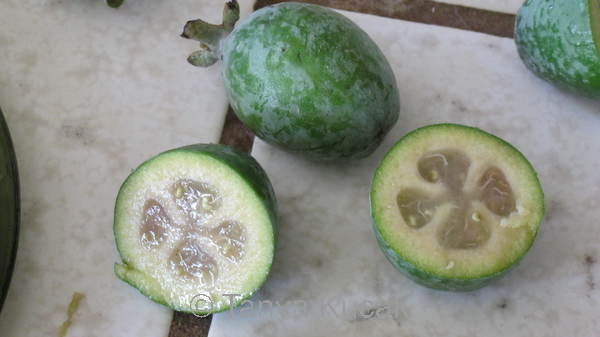
If you have a mature fruit tree, you understand the concept of abundance. But if your fruit is something out of the ordinary, you may not appreciate what you have. I've seen quinces, medlars, crabapples, and other fruits fallen and left to rot. The California Rare Fruit Growers list a thousand species of edible fruits grown around the world, only a handful of which you're likely to find at a produce stand or farmers' market.
So when I discovered a feijoa, or pineapple guava, tree in a new yard last fall, I was excited about finding out if I liked it and figuring out what to do with it. The fruit isn't ripe until it drops to the ground, but it stays firm. The small olive-green ovals, about the size of a small elongated plum or apricot, yield a soft fruit that does not turn into mush. I didn't notice them until quite a few had dropped from the tree, and then I was outside picking them up every day or so for six weeks, starting in early October. Of course, toward the end, the harvests tapered.
I probably processed, ate, and gave away nearly a hundred pounds of pineapple guavas from that single mature tree. I cut them in half and froze some with the peel, scooped out the insides and froze some pulp, incorporated feijoas into hummus, ate bagsful of them with a spoon, added some to my morning muesli, cooked them with sweet rice, made feijoa applesauce (some with cranberries), and used feijoa-ginger syrup with everything from brussels sprouts to plain soy yogurt. I didn't get tired of them, but I couldn't process them all, so I took some to every potluck and garden-related meeting, as well as to a monthly garden share.
The flavor is pleasant and mildly tropical. The peak of ripeness lasts only a day or so, while the pale yellow pulp is slightly translucent. Once it starts turning brown, they're overripe. Still tasty when they're not quite translucent, the fruits need to be eaten or processed within a few days after harvesting. Their perishability may explain why they're rarely seen in stores. A commercial feijoa industry is developing in New Zealand and Australia, however, supported by research into determining ripeness and prolonging freshness.
The plant itself is a shrub or small tree that can reach 18-25 ft. high and wide, native to South America. It's a popular landscape plant because it can be shaped or trained as needed and has attractive oval leaves, green with silvery white undersides. Though it's drought tolerant, more watering produces a better crop.
Before I learned to love the fruit, I'd been eating the delicious white flower petals for years. As long as you eat only the petals, without damaging the ovary, that flower can still turn into a fruit.
If you want to plant this shrub for the fruit, look into the variety of cultivars available and consider planting more than one for better pollination.

It's easy to cut off the blossom end, cut the feijoa in half, and scoop out the pale yellow fruit with a spoon. If you don't have time to scoop, you can freeze the fruits with the peel, for a slightly different flavor.

Most ripe fruits yield to slight pressure, but the only way to be sure is to cut them open. Feijoas are almost translucent inside, as shown, at the peak of ripeness.

Mature feijoa trees produce many fruits over a month or two in the fall. Ripe fruits fall to the ground. Place a tarp underneath and shake the shrub gently to make harvesting easier.

The sweet, succulent, pink-tinged white petals of the pineapple guava are a treat in late spring. Carefully pick one petal at a time so that the fruit can continue to develop.
© 2012 Tanya Kucak